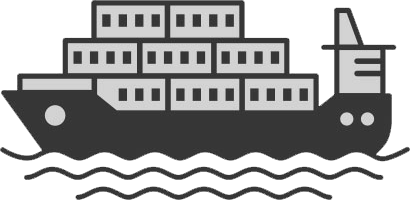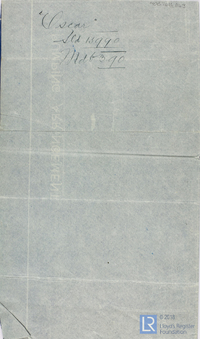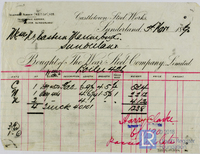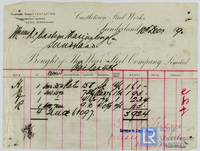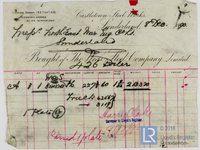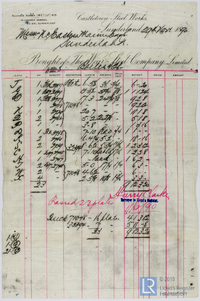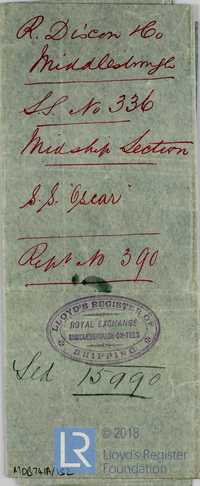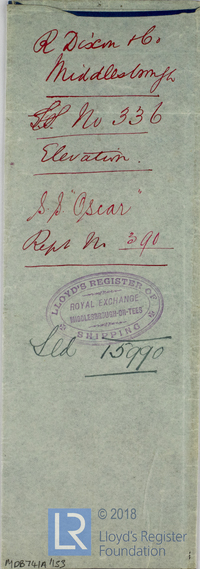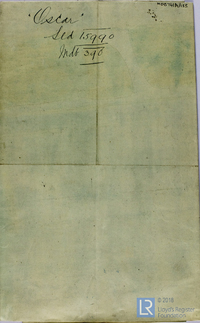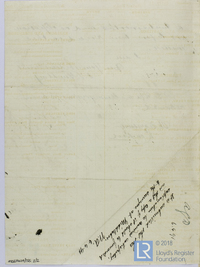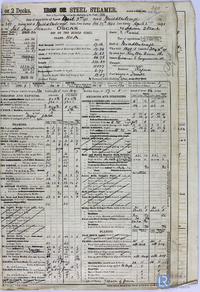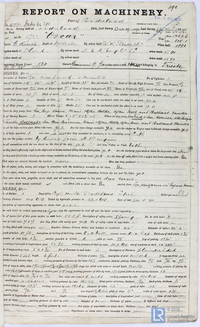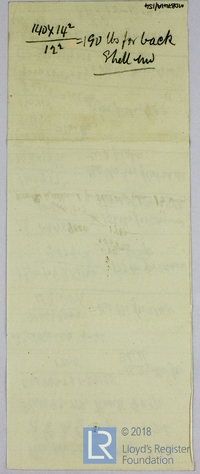- Related documents Related
- Complete documents list Documents
- Report ship? Report?
Use the data export button to extract customised data sets from the Ship Plan and Survey Report Collection. Available in TSV and CSV formats.
Name of ship as recorded on the record
Ship name
Oscar ( Pumping Arrangement for Oscar, 10 November 1890 1890, Receipt from David Colville & Sons to Thomas Farnley Iron Co Ltd relating to the case of Oscar, 31 October 1890 1890, Receipt from The Wear Steel Co Ltd to North Eastern Marine Engineering Co relating to the case of Oscar, 9 November 1890 1890, Receipt from The Wear Steel Co Ltd to North Eastern Marine Engineering Co relating to the case of Oscar, 5 November 1890 1890, Receipt from The Wear Steel Co Ltd to North Eastern Marine Engineering Co relating to the case of Oscar, 10 December 1890 1890, Receipt from The Wear Steel Co Ltd to North Eastern Marine Engineering Co relating to the case of Oscar, 8 December 1890 1890, Receipt from The Wear Steel Co Ltd to North Eastern Marine Engineering Co relating to the case of Oscar, 11 December 1890 1890, Receipt from The Wear Steel Co Ltd to North Eastern Marine Engineering Co relating to the case of Oscar, 29 November 1890 1890, Midship Section for Oscar, 22 September 1890 1890, Profile of Oscar, 22 September 1890 1890, Plan of boiler for Oscar, 11 October 1890 1890, Note relating to the case of Oscar, 2 April 1891 1891, Letter from J T Findlay, Surveyor at Sunderland, to the Secretary, Lloyd's Register, regarding the boiler of Oscar, 4 April 1891 1891, Report of Iron or Steel Steamer for Oscar, 2 April 1891 1891, Report on machinery for Oscar, 2 March 1891 1891, Note of calcuations relating to boiler of Oscar no date )
The process of transferring a vessel to water, but not necessarily her completion.
Launch Date
21/02/1891 ( Pumping Arrangement for Oscar, 10 November 1890 1890, Receipt from David Colville & Sons to Thomas Farnley Iron Co Ltd relating to the case of Oscar, 31 October 1890 1890, Receipt from The Wear Steel Co Ltd to North Eastern Marine Engineering Co relating to the case of Oscar, 9 November 1890 1890, Receipt from The Wear Steel Co Ltd to North Eastern Marine Engineering Co relating to the case of Oscar, 5 November 1890 1890, Receipt from The Wear Steel Co Ltd to North Eastern Marine Engineering Co relating to the case of Oscar, 10 December 1890 1890, Receipt from The Wear Steel Co Ltd to North Eastern Marine Engineering Co relating to the case of Oscar, 8 December 1890 1890, Receipt from The Wear Steel Co Ltd to North Eastern Marine Engineering Co relating to the case of Oscar, 11 December 1890 1890, Receipt from The Wear Steel Co Ltd to North Eastern Marine Engineering Co relating to the case of Oscar, 29 November 1890 1890, Midship Section for Oscar, 22 September 1890 1890, Profile of Oscar, 22 September 1890 1890, Plan of boiler for Oscar, 11 October 1890 1890, Note relating to the case of Oscar, 2 April 1891 1891, Letter from J T Findlay, Surveyor at Sunderland, to the Secretary, Lloyd's Register, regarding the boiler of Oscar, 4 April 1891 1891, Report of Iron or Steel Steamer for Oscar, 2 April 1891 1891, Report on machinery for Oscar, 2 March 1891 1891, Note of calcuations relating to boiler of Oscar no date )
Unique identifier for a given ship, it is assigned by a builder.
Yard no
336 ( Pumping Arrangement for Oscar, 10 November 1890 1890, Receipt from David Colville & Sons to Thomas Farnley Iron Co Ltd relating to the case of Oscar, 31 October 1890 1890, Receipt from The Wear Steel Co Ltd to North Eastern Marine Engineering Co relating to the case of Oscar, 9 November 1890 1890, Receipt from The Wear Steel Co Ltd to North Eastern Marine Engineering Co relating to the case of Oscar, 5 November 1890 1890, Receipt from The Wear Steel Co Ltd to North Eastern Marine Engineering Co relating to the case of Oscar, 10 December 1890 1890, Receipt from The Wear Steel Co Ltd to North Eastern Marine Engineering Co relating to the case of Oscar, 8 December 1890 1890, Receipt from The Wear Steel Co Ltd to North Eastern Marine Engineering Co relating to the case of Oscar, 11 December 1890 1890, Receipt from The Wear Steel Co Ltd to North Eastern Marine Engineering Co relating to the case of Oscar, 29 November 1890 1890, Midship Section for Oscar, 22 September 1890 1890, Profile of Oscar, 22 September 1890 1890, Plan of boiler for Oscar, 11 October 1890 1890, Note relating to the case of Oscar, 2 April 1891 1891, Letter from J T Findlay, Surveyor at Sunderland, to the Secretary, Lloyd's Register, regarding the boiler of Oscar, 4 April 1891 1891, Report of Iron or Steel Steamer for Oscar, 2 April 1891 1891, Report on machinery for Oscar, 2 March 1891 1891, Note of calcuations relating to boiler of Oscar no date )
The country in which the vessel’s construction took place, at the time of writing.
Country of build
United Kingdom ( Pumping Arrangement for Oscar, 10 November 1890 1890, Receipt from David Colville & Sons to Thomas Farnley Iron Co Ltd relating to the case of Oscar, 31 October 1890 1890, Receipt from The Wear Steel Co Ltd to North Eastern Marine Engineering Co relating to the case of Oscar, 9 November 1890 1890, Receipt from The Wear Steel Co Ltd to North Eastern Marine Engineering Co relating to the case of Oscar, 5 November 1890 1890, Receipt from The Wear Steel Co Ltd to North Eastern Marine Engineering Co relating to the case of Oscar, 10 December 1890 1890, Receipt from The Wear Steel Co Ltd to North Eastern Marine Engineering Co relating to the case of Oscar, 8 December 1890 1890, Receipt from The Wear Steel Co Ltd to North Eastern Marine Engineering Co relating to the case of Oscar, 11 December 1890 1890, Receipt from The Wear Steel Co Ltd to North Eastern Marine Engineering Co relating to the case of Oscar, 29 November 1890 1890, Midship Section for Oscar, 22 September 1890 1890, Profile of Oscar, 22 September 1890 1890, Plan of boiler for Oscar, 11 October 1890 1890, Note relating to the case of Oscar, 2 April 1891 1891, Letter from J T Findlay, Surveyor at Sunderland, to the Secretary, Lloyd's Register, regarding the boiler of Oscar, 4 April 1891 1891, Report of Iron or Steel Steamer for Oscar, 2 April 1891 1891, Report on machinery for Oscar, 2 March 1891 1891, Note of calcuations relating to boiler of Oscar no date )
Broad categories and subdivisions of vessels related to their purpose or function.
Ship type
Cargo ( Pumping Arrangement for Oscar, 10 November 1890 1890, Receipt from David Colville & Sons to Thomas Farnley Iron Co Ltd relating to the case of Oscar, 31 October 1890 1890, Receipt from The Wear Steel Co Ltd to North Eastern Marine Engineering Co relating to the case of Oscar, 9 November 1890 1890, Receipt from The Wear Steel Co Ltd to North Eastern Marine Engineering Co relating to the case of Oscar, 5 November 1890 1890, Receipt from The Wear Steel Co Ltd to North Eastern Marine Engineering Co relating to the case of Oscar, 10 December 1890 1890, Receipt from The Wear Steel Co Ltd to North Eastern Marine Engineering Co relating to the case of Oscar, 8 December 1890 1890, Receipt from The Wear Steel Co Ltd to North Eastern Marine Engineering Co relating to the case of Oscar, 11 December 1890 1890, Receipt from The Wear Steel Co Ltd to North Eastern Marine Engineering Co relating to the case of Oscar, 29 November 1890 1890, Midship Section for Oscar, 22 September 1890 1890, Profile of Oscar, 22 September 1890 1890, Plan of boiler for Oscar, 11 October 1890 1890, Note relating to the case of Oscar, 2 April 1891 1891, Letter from J T Findlay, Surveyor at Sunderland, to the Secretary, Lloyd's Register, regarding the boiler of Oscar, 4 April 1891 1891, Report of Iron or Steel Steamer for Oscar, 2 April 1891 1891, Report on machinery for Oscar, 2 March 1891 1891, Note of calcuations relating to boiler of Oscar no date )
Is the steamer assisted by sail?
Sail assisted steamer
No ( Pumping Arrangement for Oscar, 10 November 1890 1890, Receipt from David Colville & Sons to Thomas Farnley Iron Co Ltd relating to the case of Oscar, 31 October 1890 1890, Receipt from The Wear Steel Co Ltd to North Eastern Marine Engineering Co relating to the case of Oscar, 9 November 1890 1890, Receipt from The Wear Steel Co Ltd to North Eastern Marine Engineering Co relating to the case of Oscar, 5 November 1890 1890, Receipt from The Wear Steel Co Ltd to North Eastern Marine Engineering Co relating to the case of Oscar, 10 December 1890 1890, Receipt from The Wear Steel Co Ltd to North Eastern Marine Engineering Co relating to the case of Oscar, 8 December 1890 1890, Receipt from The Wear Steel Co Ltd to North Eastern Marine Engineering Co relating to the case of Oscar, 11 December 1890 1890, Receipt from The Wear Steel Co Ltd to North Eastern Marine Engineering Co relating to the case of Oscar, 29 November 1890 1890, Midship Section for Oscar, 22 September 1890 1890, Profile of Oscar, 22 September 1890 1890, Plan of boiler for Oscar, 11 October 1890 1890, Note relating to the case of Oscar, 2 April 1891 1891, Letter from J T Findlay, Surveyor at Sunderland, to the Secretary, Lloyd's Register, regarding the boiler of Oscar, 4 April 1891 1891, Report of Iron or Steel Steamer for Oscar, 2 April 1891 1891, Report on machinery for Oscar, 2 March 1891 1891, Note of calcuations relating to boiler of Oscar no date )
Is machinery fitted at the aft of the vessel?
Machinery aft?
No ( Pumping Arrangement for Oscar, 10 November 1890 1890, Receipt from David Colville & Sons to Thomas Farnley Iron Co Ltd relating to the case of Oscar, 31 October 1890 1890, Receipt from The Wear Steel Co Ltd to North Eastern Marine Engineering Co relating to the case of Oscar, 9 November 1890 1890, Receipt from The Wear Steel Co Ltd to North Eastern Marine Engineering Co relating to the case of Oscar, 5 November 1890 1890, Receipt from The Wear Steel Co Ltd to North Eastern Marine Engineering Co relating to the case of Oscar, 10 December 1890 1890, Receipt from The Wear Steel Co Ltd to North Eastern Marine Engineering Co relating to the case of Oscar, 8 December 1890 1890, Receipt from The Wear Steel Co Ltd to North Eastern Marine Engineering Co relating to the case of Oscar, 11 December 1890 1890, Receipt from The Wear Steel Co Ltd to North Eastern Marine Engineering Co relating to the case of Oscar, 29 November 1890 1890, Midship Section for Oscar, 22 September 1890 1890, Profile of Oscar, 22 September 1890 1890, Plan of boiler for Oscar, 11 October 1890 1890, Note relating to the case of Oscar, 2 April 1891 1891, Letter from J T Findlay, Surveyor at Sunderland, to the Secretary, Lloyd's Register, regarding the boiler of Oscar, 4 April 1891 1891, Report of Iron or Steel Steamer for Oscar, 2 April 1891 1891, Report on machinery for Oscar, 2 March 1891 1891, Note of calcuations relating to boiler of Oscar no date )
Generally a smaller additional auxiliary boiler (often used while the vessel is at port).
Is a donkey boiler fitted?
No ( Pumping Arrangement for Oscar, 10 November 1890 1890, Receipt from David Colville & Sons to Thomas Farnley Iron Co Ltd relating to the case of Oscar, 31 October 1890 1890, Receipt from The Wear Steel Co Ltd to North Eastern Marine Engineering Co relating to the case of Oscar, 9 November 1890 1890, Receipt from The Wear Steel Co Ltd to North Eastern Marine Engineering Co relating to the case of Oscar, 5 November 1890 1890, Receipt from The Wear Steel Co Ltd to North Eastern Marine Engineering Co relating to the case of Oscar, 10 December 1890 1890, Receipt from The Wear Steel Co Ltd to North Eastern Marine Engineering Co relating to the case of Oscar, 8 December 1890 1890, Receipt from The Wear Steel Co Ltd to North Eastern Marine Engineering Co relating to the case of Oscar, 11 December 1890 1890, Receipt from The Wear Steel Co Ltd to North Eastern Marine Engineering Co relating to the case of Oscar, 29 November 1890 1890, Midship Section for Oscar, 22 September 1890 1890, Profile of Oscar, 22 September 1890 1890, Plan of boiler for Oscar, 11 October 1890 1890, Note relating to the case of Oscar, 2 April 1891 1891, Letter from J T Findlay, Surveyor at Sunderland, to the Secretary, Lloyd's Register, regarding the boiler of Oscar, 4 April 1891 1891, Report of Iron or Steel Steamer for Oscar, 2 April 1891 1891, Report on machinery for Oscar, 2 March 1891 1891, Note of calcuations relating to boiler of Oscar no date )
Name of the Proving House responsible for the public testing and certification of a vessel’s anchors and/or chain cables.
Lloyd's Proving House?
No ( Pumping Arrangement for Oscar, 10 November 1890 1890, Receipt from David Colville & Sons to Thomas Farnley Iron Co Ltd relating to the case of Oscar, 31 October 1890 1890, Receipt from The Wear Steel Co Ltd to North Eastern Marine Engineering Co relating to the case of Oscar, 9 November 1890 1890, Receipt from The Wear Steel Co Ltd to North Eastern Marine Engineering Co relating to the case of Oscar, 5 November 1890 1890, Receipt from The Wear Steel Co Ltd to North Eastern Marine Engineering Co relating to the case of Oscar, 10 December 1890 1890, Receipt from The Wear Steel Co Ltd to North Eastern Marine Engineering Co relating to the case of Oscar, 8 December 1890 1890, Receipt from The Wear Steel Co Ltd to North Eastern Marine Engineering Co relating to the case of Oscar, 11 December 1890 1890, Receipt from The Wear Steel Co Ltd to North Eastern Marine Engineering Co relating to the case of Oscar, 29 November 1890 1890, Midship Section for Oscar, 22 September 1890 1890, Profile of Oscar, 22 September 1890 1890, Plan of boiler for Oscar, 11 October 1890 1890, Note relating to the case of Oscar, 2 April 1891 1891, Letter from J T Findlay, Surveyor at Sunderland, to the Secretary, Lloyd's Register, regarding the boiler of Oscar, 4 April 1891 1891, Report of Iron or Steel Steamer for Oscar, 2 April 1891 1891, Report on machinery for Oscar, 2 March 1891 1891, Note of calcuations relating to boiler of Oscar no date )
Maximum length of a vessel’s hull measured parallel to the waterline.
Length Overall
Name of surveyor.
The country (flag) that a vessel is registered to, at the time of writing.
Country of registration
Trieste ( Report of Iron or Steel Steamer for Oscar, 2 April 1891 1891, Report on machinery for Oscar, 2 March 1891 1891 )
The individual and/or organisation listed
Ship owner
Giovanni G Gargurevich & Co ( Report of Iron or Steel Steamer for Oscar, 2 April 1891 1891, Report on machinery for Oscar, 2 March 1891 1891 )
Classification symbol assigned to a vessel by Lloyd’s Register’s Classing Committee denoting the quality of construction and maintenance.
Classification
100A1 steel; 1 dk (iron) & web frames; well dk; +LMC 4/91; a & cp ( Report of Iron or Steel Steamer for Oscar, 2 April 1891 1891 )
+LMC 4/91 ( Report on machinery for Oscar, 2 March 1891 1891 )
A ship’s total internal capacity of a ship measured in register tons from the top of the floors to the tonnage deck.
Under Deck Tonnage
989 ( Report of Iron or Steel Steamer for Oscar, 2 April 1891 1891 )
Prescribed by flag/registration authorities, and usually excludes a small part of the stern. It is measured from the foreside of the stern at the extreme top to the afterside of the stern post.
Registered Length
234 ( Report of Iron or Steel Steamer for Oscar, 2 April 1891 1891 )
Measurement from the underside of the upper deck on the centre line to the upper side of the bottom plating.
Registered Depth
16.2 ( Report of Iron or Steel Steamer for Oscar, 2 April 1891 1891 )
Location of construction for a vessel’s engines.
Location of engine build
Sunderland ( Report on machinery for Oscar, 2 March 1891 1891 )
Date in which construction of a vessel’s engines were completed.
Year of engine build
The year in which a vessel’s construction is completed.
Year of ship completion
1891 ( Pumping Arrangement for Oscar, 10 November 1890 1890, Receipt from David Colville & Sons to Thomas Farnley Iron Co Ltd relating to the case of Oscar, 31 October 1890 1890, Receipt from The Wear Steel Co Ltd to North Eastern Marine Engineering Co relating to the case of Oscar, 9 November 1890 1890, Receipt from The Wear Steel Co Ltd to North Eastern Marine Engineering Co relating to the case of Oscar, 5 November 1890 1890, Receipt from The Wear Steel Co Ltd to North Eastern Marine Engineering Co relating to the case of Oscar, 10 December 1890 1890, Receipt from The Wear Steel Co Ltd to North Eastern Marine Engineering Co relating to the case of Oscar, 8 December 1890 1890, Receipt from The Wear Steel Co Ltd to North Eastern Marine Engineering Co relating to the case of Oscar, 11 December 1890 1890, Receipt from The Wear Steel Co Ltd to North Eastern Marine Engineering Co relating to the case of Oscar, 29 November 1890 1890, Midship Section for Oscar, 22 September 1890 1890, Profile of Oscar, 22 September 1890 1890, Plan of boiler for Oscar, 11 October 1890 1890, Note relating to the case of Oscar, 2 April 1891 1891, Letter from J T Findlay, Surveyor at Sunderland, to the Secretary, Lloyd's Register, regarding the boiler of Oscar, 4 April 1891 1891, Report of Iron or Steel Steamer for Oscar, 2 April 1891 1891, Report on machinery for Oscar, 2 March 1891 1891, Note of calcuations relating to boiler of Oscar no date )
The individual and/or organisation listed as having been responsible for constructing the vessel. This can/may be the same as the owner and/or manager.
Shipbuilder
Raylton Dixon & Co ( Pumping Arrangement for Oscar, 10 November 1890 1890, Receipt from David Colville & Sons to Thomas Farnley Iron Co Ltd relating to the case of Oscar, 31 October 1890 1890, Receipt from The Wear Steel Co Ltd to North Eastern Marine Engineering Co relating to the case of Oscar, 9 November 1890 1890, Receipt from The Wear Steel Co Ltd to North Eastern Marine Engineering Co relating to the case of Oscar, 5 November 1890 1890, Receipt from The Wear Steel Co Ltd to North Eastern Marine Engineering Co relating to the case of Oscar, 10 December 1890 1890, Receipt from The Wear Steel Co Ltd to North Eastern Marine Engineering Co relating to the case of Oscar, 8 December 1890 1890, Receipt from The Wear Steel Co Ltd to North Eastern Marine Engineering Co relating to the case of Oscar, 11 December 1890 1890, Receipt from The Wear Steel Co Ltd to North Eastern Marine Engineering Co relating to the case of Oscar, 29 November 1890 1890, Midship Section for Oscar, 22 September 1890 1890, Profile of Oscar, 22 September 1890 1890, Plan of boiler for Oscar, 11 October 1890 1890, Note relating to the case of Oscar, 2 April 1891 1891, Letter from J T Findlay, Surveyor at Sunderland, to the Secretary, Lloyd's Register, regarding the boiler of Oscar, 4 April 1891 1891, Report of Iron or Steel Steamer for Oscar, 2 April 1891 1891, Report on machinery for Oscar, 2 March 1891 1891, Note of calcuations relating to boiler of Oscar no date )
The port or place in which the vessel’s construction took place, at the time of writing.
Place of build
Middlesbrough ( Pumping Arrangement for Oscar, 10 November 1890 1890, Receipt from David Colville & Sons to Thomas Farnley Iron Co Ltd relating to the case of Oscar, 31 October 1890 1890, Receipt from The Wear Steel Co Ltd to North Eastern Marine Engineering Co relating to the case of Oscar, 9 November 1890 1890, Receipt from The Wear Steel Co Ltd to North Eastern Marine Engineering Co relating to the case of Oscar, 5 November 1890 1890, Receipt from The Wear Steel Co Ltd to North Eastern Marine Engineering Co relating to the case of Oscar, 10 December 1890 1890, Receipt from The Wear Steel Co Ltd to North Eastern Marine Engineering Co relating to the case of Oscar, 8 December 1890 1890, Receipt from The Wear Steel Co Ltd to North Eastern Marine Engineering Co relating to the case of Oscar, 11 December 1890 1890, Receipt from The Wear Steel Co Ltd to North Eastern Marine Engineering Co relating to the case of Oscar, 29 November 1890 1890, Midship Section for Oscar, 22 September 1890 1890, Profile of Oscar, 22 September 1890 1890, Plan of boiler for Oscar, 11 October 1890 1890, Note relating to the case of Oscar, 2 April 1891 1891, Letter from J T Findlay, Surveyor at Sunderland, to the Secretary, Lloyd's Register, regarding the boiler of Oscar, 4 April 1891 1891, Report of Iron or Steel Steamer for Oscar, 2 April 1891 1891, Report on machinery for Oscar, 2 March 1891 1891, Note of calcuations relating to boiler of Oscar no date )
Location where a vessel’s survey was undertaken.
Location of Survey
Middlesbrough ( Pumping Arrangement for Oscar, 10 November 1890 1890, Midship Section for Oscar, 22 September 1890 1890, Profile of Oscar, 22 September 1890 1890, Report of Iron or Steel Steamer for Oscar, 2 April 1891 1891 )
Motherwell ( Receipt from David Colville & Sons to Thomas Farnley Iron Co Ltd relating to the case of Oscar, 31 October 1890 1890 )
Sunderland ( Receipt from The Wear Steel Co Ltd to North Eastern Marine Engineering Co relating to the case of Oscar, 9 November 1890 1890, Receipt from The Wear Steel Co Ltd to North Eastern Marine Engineering Co relating to the case of Oscar, 5 November 1890 1890, Receipt from The Wear Steel Co Ltd to North Eastern Marine Engineering Co relating to the case of Oscar, 10 December 1890 1890, Receipt from The Wear Steel Co Ltd to North Eastern Marine Engineering Co relating to the case of Oscar, 8 December 1890 1890, Receipt from The Wear Steel Co Ltd to North Eastern Marine Engineering Co relating to the case of Oscar, 11 December 1890 1890, Receipt from The Wear Steel Co Ltd to North Eastern Marine Engineering Co relating to the case of Oscar, 29 November 1890 1890, Plan of boiler for Oscar, 11 October 1890 1890, Note relating to the case of Oscar, 2 April 1891 1891, Letter from J T Findlay, Surveyor at Sunderland, to the Secretary, Lloyd's Register, regarding the boiler of Oscar, 4 April 1891 1891, Report on machinery for Oscar, 2 March 1891 1891 )
A vessel’s means of propulsion.
Propulsion
Steam ( Pumping Arrangement for Oscar, 10 November 1890 1890, Receipt from David Colville & Sons to Thomas Farnley Iron Co Ltd relating to the case of Oscar, 31 October 1890 1890, Receipt from The Wear Steel Co Ltd to North Eastern Marine Engineering Co relating to the case of Oscar, 9 November 1890 1890, Receipt from The Wear Steel Co Ltd to North Eastern Marine Engineering Co relating to the case of Oscar, 5 November 1890 1890, Receipt from The Wear Steel Co Ltd to North Eastern Marine Engineering Co relating to the case of Oscar, 10 December 1890 1890, Receipt from The Wear Steel Co Ltd to North Eastern Marine Engineering Co relating to the case of Oscar, 8 December 1890 1890, Receipt from The Wear Steel Co Ltd to North Eastern Marine Engineering Co relating to the case of Oscar, 11 December 1890 1890, Receipt from The Wear Steel Co Ltd to North Eastern Marine Engineering Co relating to the case of Oscar, 29 November 1890 1890, Midship Section for Oscar, 22 September 1890 1890, Profile of Oscar, 22 September 1890 1890, Plan of boiler for Oscar, 11 October 1890 1890, Note relating to the case of Oscar, 2 April 1891 1891, Letter from J T Findlay, Surveyor at Sunderland, to the Secretary, Lloyd's Register, regarding the boiler of Oscar, 4 April 1891 1891, Report of Iron or Steel Steamer for Oscar, 2 April 1891 1891, Report on machinery for Oscar, 2 March 1891 1891, Note of calcuations relating to boiler of Oscar no date )
Confirmation as to whether the vessel was equipped with refrigeration machinery to aid in the transport of frozen or chilled cargo/goods.
Refrigeration machinery fitted for cargo purposes?
No ( Pumping Arrangement for Oscar, 10 November 1890 1890, Receipt from David Colville & Sons to Thomas Farnley Iron Co Ltd relating to the case of Oscar, 31 October 1890 1890, Receipt from The Wear Steel Co Ltd to North Eastern Marine Engineering Co relating to the case of Oscar, 9 November 1890 1890, Receipt from The Wear Steel Co Ltd to North Eastern Marine Engineering Co relating to the case of Oscar, 5 November 1890 1890, Receipt from The Wear Steel Co Ltd to North Eastern Marine Engineering Co relating to the case of Oscar, 10 December 1890 1890, Receipt from The Wear Steel Co Ltd to North Eastern Marine Engineering Co relating to the case of Oscar, 8 December 1890 1890, Receipt from The Wear Steel Co Ltd to North Eastern Marine Engineering Co relating to the case of Oscar, 11 December 1890 1890, Receipt from The Wear Steel Co Ltd to North Eastern Marine Engineering Co relating to the case of Oscar, 29 November 1890 1890, Midship Section for Oscar, 22 September 1890 1890, Profile of Oscar, 22 September 1890 1890, Plan of boiler for Oscar, 11 October 1890 1890, Note relating to the case of Oscar, 2 April 1891 1891, Letter from J T Findlay, Surveyor at Sunderland, to the Secretary, Lloyd's Register, regarding the boiler of Oscar, 4 April 1891 1891, Report of Iron or Steel Steamer for Oscar, 2 April 1891 1891, Report on machinery for Oscar, 2 March 1891 1891, Note of calcuations relating to boiler of Oscar no date )
Does the vessel possess an auxiliary power source?
Auxillary
No ( Pumping Arrangement for Oscar, 10 November 1890 1890, Receipt from David Colville & Sons to Thomas Farnley Iron Co Ltd relating to the case of Oscar, 31 October 1890 1890, Receipt from The Wear Steel Co Ltd to North Eastern Marine Engineering Co relating to the case of Oscar, 9 November 1890 1890, Receipt from The Wear Steel Co Ltd to North Eastern Marine Engineering Co relating to the case of Oscar, 5 November 1890 1890, Receipt from The Wear Steel Co Ltd to North Eastern Marine Engineering Co relating to the case of Oscar, 10 December 1890 1890, Receipt from The Wear Steel Co Ltd to North Eastern Marine Engineering Co relating to the case of Oscar, 8 December 1890 1890, Receipt from The Wear Steel Co Ltd to North Eastern Marine Engineering Co relating to the case of Oscar, 11 December 1890 1890, Receipt from The Wear Steel Co Ltd to North Eastern Marine Engineering Co relating to the case of Oscar, 29 November 1890 1890, Midship Section for Oscar, 22 September 1890 1890, Profile of Oscar, 22 September 1890 1890, Plan of boiler for Oscar, 11 October 1890 1890, Note relating to the case of Oscar, 2 April 1891 1891, Letter from J T Findlay, Surveyor at Sunderland, to the Secretary, Lloyd's Register, regarding the boiler of Oscar, 4 April 1891 1891, Report of Iron or Steel Steamer for Oscar, 2 April 1891 1891, Report on machinery for Oscar, 2 March 1891 1891, Note of calcuations relating to boiler of Oscar no date )
Is electric lighting fitted to the vessel?
Electric light fitted?
No ( Pumping Arrangement for Oscar, 10 November 1890 1890, Receipt from David Colville & Sons to Thomas Farnley Iron Co Ltd relating to the case of Oscar, 31 October 1890 1890, Receipt from The Wear Steel Co Ltd to North Eastern Marine Engineering Co relating to the case of Oscar, 9 November 1890 1890, Receipt from The Wear Steel Co Ltd to North Eastern Marine Engineering Co relating to the case of Oscar, 5 November 1890 1890, Receipt from The Wear Steel Co Ltd to North Eastern Marine Engineering Co relating to the case of Oscar, 10 December 1890 1890, Receipt from The Wear Steel Co Ltd to North Eastern Marine Engineering Co relating to the case of Oscar, 8 December 1890 1890, Receipt from The Wear Steel Co Ltd to North Eastern Marine Engineering Co relating to the case of Oscar, 11 December 1890 1890, Receipt from The Wear Steel Co Ltd to North Eastern Marine Engineering Co relating to the case of Oscar, 29 November 1890 1890, Midship Section for Oscar, 22 September 1890 1890, Profile of Oscar, 22 September 1890 1890, Plan of boiler for Oscar, 11 October 1890 1890, Note relating to the case of Oscar, 2 April 1891 1891, Letter from J T Findlay, Surveyor at Sunderland, to the Secretary, Lloyd's Register, regarding the boiler of Oscar, 4 April 1891 1891, Report of Iron or Steel Steamer for Oscar, 2 April 1891 1891, Report on machinery for Oscar, 2 March 1891 1891, Note of calcuations relating to boiler of Oscar no date )
Predominant material(s) utilised in a vessel’s construction.
Material of construction
Steel ( Midship Section for Oscar, 22 September 1890 1890, Report of Iron or Steel Steamer for Oscar, 2 April 1891 1891 )
Measurement from the extreme outboard point of starboard to the extreme outboard point of port.
Extreme Breadth
Abbreviations of the names of ports with Lloyd’s Register survey offices.
Port of survey abbreviations
Mdb ( Report of Iron or Steel Steamer for Oscar, 2 April 1891 1891 )
The listed port to which a given vessel belongs.
Port belonging to
Trieste ( Report of Iron or Steel Steamer for Oscar, 2 April 1891 1891, Report on machinery for Oscar, 2 March 1891 1891 )
An officially licensed mariner (post 1850) holding ultimate command and responsibility for a vessel.
A ship’s total internal volume in ‘register tons’ (replaced by gross tonnage post 1982).
Gross Register Tonnage
1270 ( Report of Iron or Steel Steamer for Oscar, 2 April 1891 1891, Report on machinery for Oscar, 2 March 1891 1891 )
Tonnage derived by deducting from the gross register tonnage the capacity that in unavailable for cargo, e.g. machinery space, fuel, crew accommodation etc.
Net Register Tonnage
818 ( Report of Iron or Steel Steamer for Oscar, 2 April 1891 1891, Report on machinery for Oscar, 2 March 1891 1891 )
Also referred to as extreme breadth. The distance from the extreme starboard side to the extreme port side.
Registered Beam
34.5 ( Report of Iron or Steel Steamer for Oscar, 2 April 1891 1891 )
Description/specifications listed of the vessel’s engines and machinery. (The engines/machinery may have been surveyed separately before being assigned to a vessel).
Engine/Machinery details
Triple compound 3 cranks ( Report on machinery for Oscar, 2 March 1891 1891 )
The country, at the time of writing, where a vessel’s engines were constructed.
Country of engine build
United Kingdom ( Report on machinery for Oscar, 2 March 1891 1891 )
Horsepower registered
Report an issue with this ship
Have you noticed missing or incorrect data or images for this ship?
Please let us know and we will rectify the issue as soon as possible.
